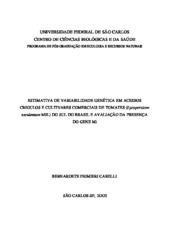Estimativa de variabilidade genética em acessos crioulos e cultivares comerciais de tomates (Lycopersicon esculentum Mill.) do sul do Brasil e avaliação da presença do Gene Mi
Abstract
Cultivated tomato (Lycopersicon esculentum Mill.) is one of the most important
horticultural crops. Although original from the Andes region, this crop was officially introduced
in Brazil by the European immigrants during the last half of the XIX century. Today, old varieties
and new improved cultivars are planted in the different Brazilian regions. In the last 20 years the
Ecological Center of Ipê proceeded a rescue of old tomato varieties maintained by small
agriculturists in the Northeast region of Rio Grande do Sul State. The present work had the
objective to estimate the variability among 35 tomato accessions, 12 commercial cultivars and 23
Brazilian landraces using morphological descriptors and molecular traits (proteins and DNA),
and to verify the Meloidogyne resistance/susceptibility status of these genotypes, as well as the
presence of the Mi genes. The landraces were separate in five groups by their fruit characteristics:
large oblate, cherry, heart-shape, large cylindrical, and rounded, whereas the commercial
cultivars were restricted to the most common groups in the market. Both the quantitative
evaluation of seed protein electrophoretic profiles, and RAPD markers allowed identifying all the
accessions. The cluster analysis of RAPD data allowed to separate the genotypes in seven
similarity groups that were not related with those formed by the protein analysis. Conversely, a
discriminant analysis showed a relation between RAPD markers and fruit morphology. Landraces
exhibited higher levels of protein and genetic (RAPD) variations compared with the commercial
cultivars confirming the genetic variability reduction caused by the limited number of genotypes
used in breeding programs. Experimental results showed that all the landraces and commercial
cultivars, with the exception of the cultivars Polka Baixo and Gaucho (Feltrin) were susceptible
to M. javanica, M. incognita, and M. arenaria. PCR data showed that the Mi1.2 gene was present
only in the Polka Baixo cultivar, whereas the Mi1.1 was found in 26 accessions, most of which
susceptible to root-knot nematodes, confirming the gene Mi1.2 as the nematode resistant
determinant, and the inefficiency of the Mi1.1. Considering the high incidence of Meloidogyne in
South Brazil, the low frequency of resistant accessions point-out the necessity of a special effort
of breeding programs on the transfer of root-knot nematode resistance genes to Brazilian tomato
varieties and cultivars.
